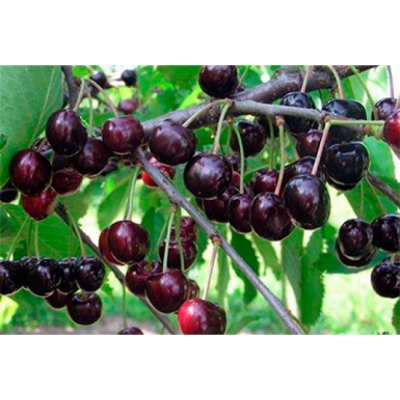
- Pruning: annual formative
- Fruit shape: round, blunt-hearted
- Peduncle: medium, separates well from the branch, attachment to the bone is fragile
- Authors: Zueva Lidia Ivanovna, Kanshina Maina Vladimirovna, Astakhov Alexey Alexandrovich
- Year of approval: 2014
- Growth type: medium-sized
- Appointment: universal
- Tree height, m: up to 4
- Crown: spreading, medium density
- Escapes: thick, straight, horizontal, light brown
Cherry in Memory of Astakhov belongs to young varieties, but it is highly respected among gardeners for its unpretentiousness, ability to grow and bear fruit in risky farming zones. Cherry fruits have a universal purpose, they are suitable both for fresh consumption and for freezing, preservation and preparation of confectionery.
Breeding history
The originators of the variety are L.I. Zueva, M.V. Kanshina, A.A. Astakhov. After many years of variety testing in 2014 in Memory of Astakhov, it was registered in the State Register of Breeding Achievements of the Russian Federation.
Description of the variety
A medium-sized (from 3 to 4 m) tree with a spreading crown of medium density, covered with large leaves, looks very decorative at the time of flowering. It is no less beautiful in autumn, when the leaves change colors to a red-burgundy palette. Straight, thick horizontal shoots are covered with light brown bark, thinner branches have a thin peeling skin of a light gray hue. A large leafy elongated-oval green plate has serrated edges and a long-pointed tip. Medium-sized snow-white flowers are collected in inflorescences of 3 pieces, the main part of the ovary is formed on bouquet twigs. The fruits are characterized by dry separation, the medium-sized stone is easily separated from the pulp.
Fruit characteristics
Medium-sized fruits of a rounded blunt-hearted shape have a weight of 6.1 to 7.2 grams. The delicate but dense glossy skin allows you to store the crop for up to two weeks in a refrigerator or a specially equipped storage facility, and provides the possibility of transportability over long distances. The berry is attached to the stalk of medium length and thickness; the attachment to the stone is rather loose.
Taste qualities
Delicate and juicy, slightly gristly, dark red pulp has a sweet taste and a rich vitamin and mineral composition. In addition, the fruits contain 18.3% dry matter, 14.6% sugars, 0.52% acid and 19.2% vitamin C.
Ripening and fruiting
The variety belongs to the mid-late category. The approximate flowering of sweet cherry begins at the end of May, the harvest is harvested at the end of July. However, do not forget about growing crops in completely different climatic zones. In the southern regions, flowering and harvesting begins at least two weeks earlier than in the Urals. Irregular fruiting begins 5 years after planting.

Yield
In terms of the amount of yield, the variety belongs to the average type, since an average of 70-80 kg or 82 kg / ha is harvested from an adult tree, which is far from the limit of the crop's capabilities.
Growing regions
Initially, the variety was adapted to the middle zone of the Russian Federation, but variety trials showed results that surpassed the hopes of breeders. In memory of Astakhov, it grows well and bears fruit not only in the central part, but also in the Urals, and even in Altai.
Self-fertility and the need for pollinators
Self-fertile sweet cherry in Memory of Astakhov needs nearby pollinating varieties with the same flowering time. Most suitable: Revna, Tyutchevka, Iput, Ovstuzhenka.
Growing and care
For planting, choose sunny areas with the maximum approximation of groundwater no more than three meters. The plant grows well only on fertile soil with a neutral acidity level. Strongly acidic soil needs to be deoxidized with dolomite flour, liming, adding chalk or gypsum. Seedlings 2-3 years old with a well-developed root and buds are chosen as planting material.
Optimal timing for planting: early spring one month before flowering or the second half of summer until mid-September. Before planting in summer, the seedling is kept for 10-15 days in the basement, without removing the roots from the packaging. The dimensions of the planting pit are 60x60x60 cm. The distance between the holes is 3 meters, in row spacings from 5 to 7 meters. At the bottom of the pit, a drainage 10-15-centimeter layer of gravel, pebbles, and broken brick is poured. The excavated soil is enriched with humus, compost or bird droppings, 0.5 kg of superphosphate and 1 kg of wood ash are added. When planting a seedling, it is necessary to ensure that the root collar is above ground level. The trunk circle is watered abundantly with warm water and the next day it is loosened.
Further care of the plant consists in watering, loosening, weeding, feeding, forming and sanitary annual pruning. Watering is carried out at intervals of 1 month for an adult tree and weekly in dry weather for plants in the first season after planting. Formative pruning creates a three-tiered arrangement of shoots.




Disease and pest resistance
Strong immunity allows the plant to successfully resist diseases and pests. No fungal lesions were observed.

Requirements for soil and climatic conditions
The variety has good frost resistance (up to -32ºC) and drought resistance - the tree can survive a month's lack of moisture.
































































